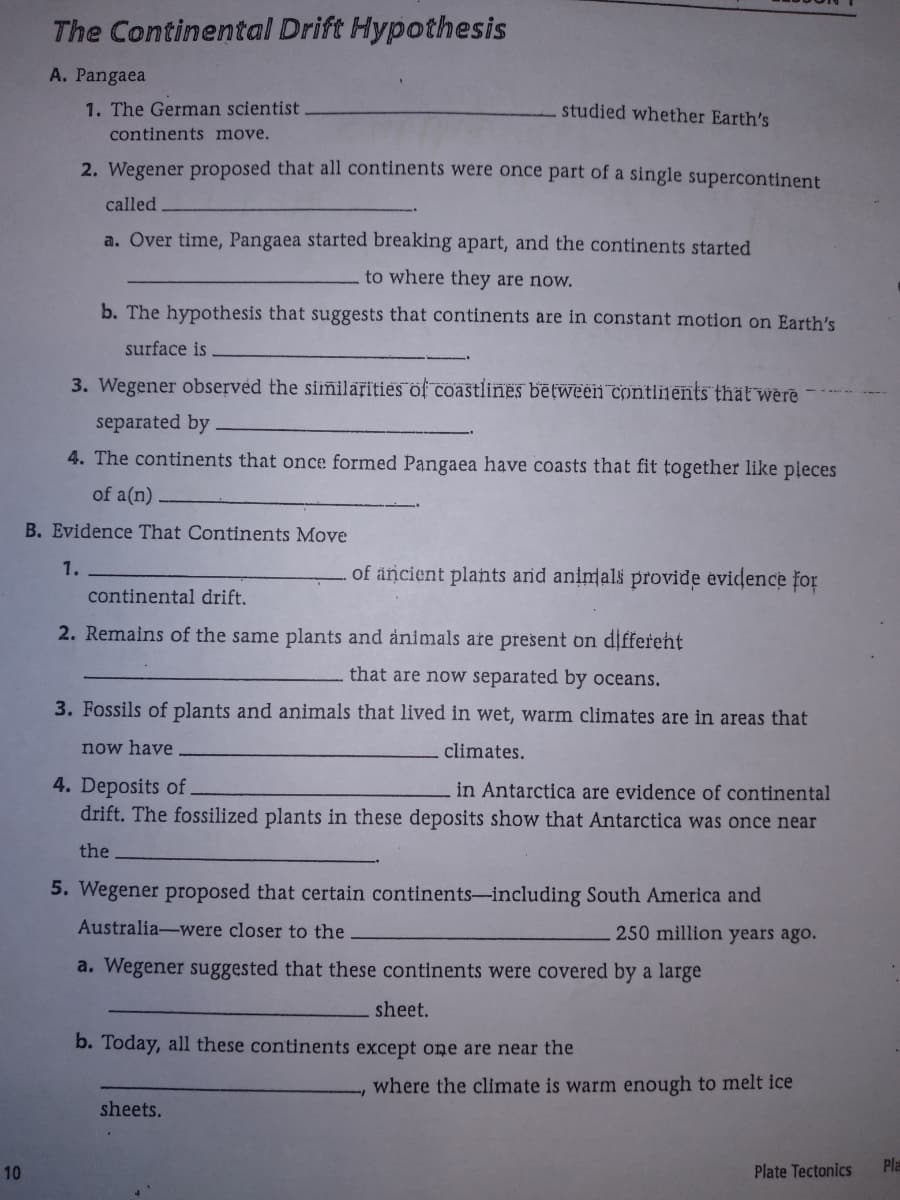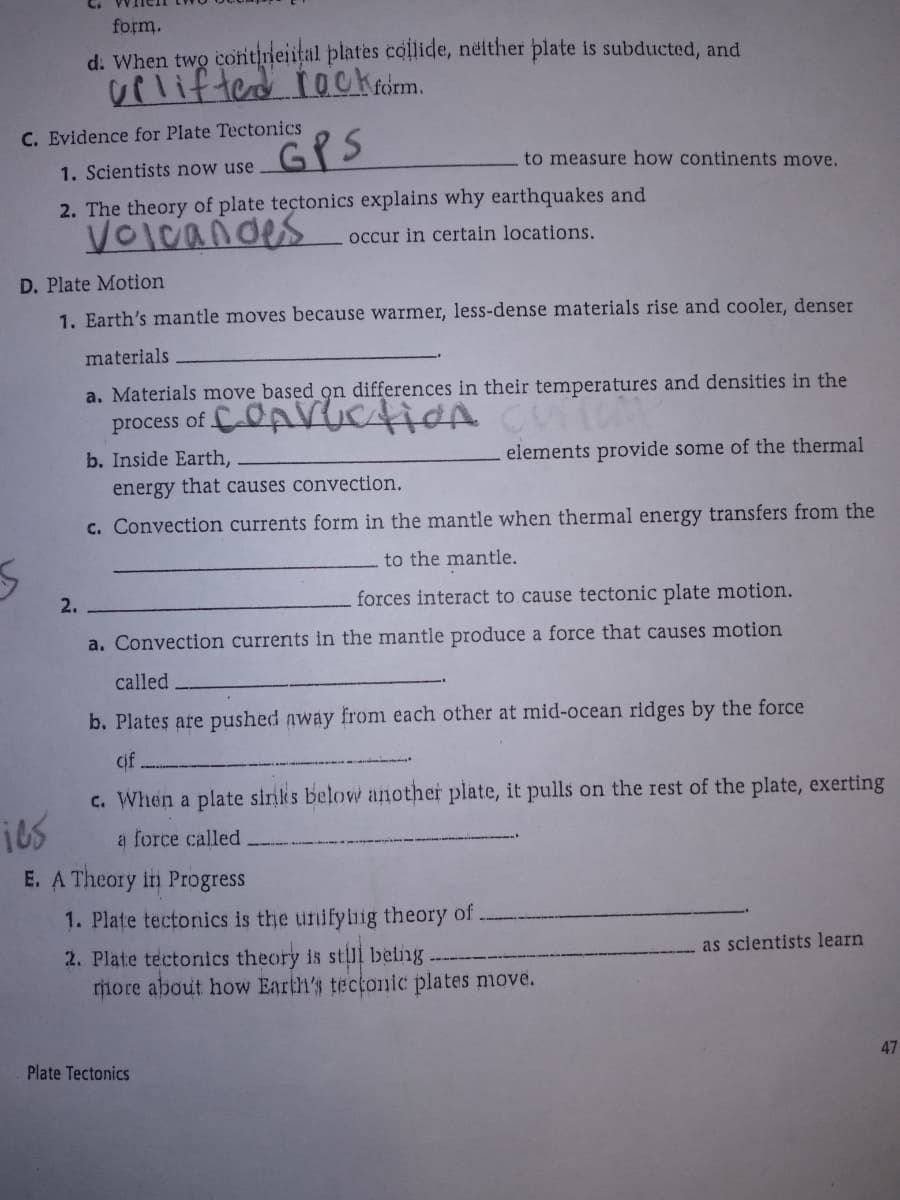The Continental Drift Hypothesis A. Pangaea 1. The German scientist studied whether Earth's continents move. 2. Wegener proposed that all continents were once part of a single supercontinent called a. Over time, Pangaea started breaking apart, and the continents started to where they are now. b. The hypothesis that suggests that continents are in constant motion on Earth's surface is
The Continental Drift Hypothesis A. Pangaea 1. The German scientist studied whether Earth's continents move. 2. Wegener proposed that all continents were once part of a single supercontinent called a. Over time, Pangaea started breaking apart, and the continents started to where they are now. b. The hypothesis that suggests that continents are in constant motion on Earth's surface is
Applications and Investigations in Earth Science (9th Edition)
9th Edition
ISBN:9780134746241
Author:Edward J. Tarbuck, Frederick K. Lutgens, Dennis G. Tasa
Publisher:Edward J. Tarbuck, Frederick K. Lutgens, Dennis G. Tasa
Chapter1: The Study Of Minerals
Section: Chapter Questions
Problem 1LR
Related questions
Question

Transcribed Image Text:The Continental Drift Hypothesis
A. Pangaea
1. The German scientist
studied whether Earth's
continents move.
2. Wegener proposed that all continents were once part of a single supercontinent
called
a. Over time, Pangaea started breaking apart, and the continents started
to where they are now.
b. The hypothesis that suggests that continents are in constant motion on Earth's
surface is
3. Wegener observed the similärities of coastlines between contlinents that were
separated by
4. The continents that once formed Pangaea have coasts that fit together like pleces
of a(n)
B. Evidence That Continents Move
1.
of äncient plants and animals provide evidence for
continental drift.
2. Remains of the same plants and ånimals are present on differeht
that are now separated by oceans.
3. Fossils of plants and animals that lived in wet, warm climates are in areas that
now have
climates.
4. Deposits of.
drift. The fossilized plants in these deposits show that Antarctica was once near
in Antarctica are evidence of continental
the
5. Wegener proposed that certain continents-including South America and
Australia-were closer to the
250 million years ago.
a. Wegener suggested that these continents were covered by a large
sheet.
b. Today, all these continents except one are near the
where the climate is warm enough to melt ice
sheets.
10
Plate Tectonics
Pla

Transcribed Image Text:form.
d. When two contineiital plates collide, neither plate is subducted, and
uplifted rackrom.
C. Evidence for Plate Tectonics
GPS
1. Scientists now use
to measure how continents move.
2. The theory of plate tectonics explains why earthquakes and
Volcañdes
occur in certain locations.
D. Plate Motion
1. Earth's mantle moves because warmer, less-dense materials rise and cooler, denser
materials
a. Materials move based on differences in their temperatures and densities in the
process of CAVUstion CuTM
b. Inside Earth,
elements provide some of the thermal
energy that causes convection.
c. Convection currents form in the mantle when thermal energy transfers from the
to the mantle.
2.
forces interact to cause tectonic plate motion.
a. Convection currents in the mantle produce a force that causes motion
called
b. Plates are pushed away from each other at mid-ocean ridges by the force
oif
c. When a plate sinks below another plate, it pulls on the rest of the plate, exerting
a force called
E. A Theory in Progress
1. Plate tectonics is the unifyinig theory of.
2. Plate tectonics theory is stlil belng
riore about how Earth's tectonic plates move.
as sclentists learn
Plate Tectonics
47
Expert Solution
This question has been solved!
Explore an expertly crafted, step-by-step solution for a thorough understanding of key concepts.
This is a popular solution!
Trending now
This is a popular solution!
Step by step
Solved in 4 steps

Recommended textbooks for you

Applications and Investigations in Earth Science …
Earth Science
ISBN:
9780134746241
Author:
Edward J. Tarbuck, Frederick K. Lutgens, Dennis G. Tasa
Publisher:
PEARSON

Exercises for Weather & Climate (9th Edition)
Earth Science
ISBN:
9780134041360
Author:
Greg Carbone
Publisher:
PEARSON

Environmental Science
Earth Science
ISBN:
9781260153125
Author:
William P Cunningham Prof., Mary Ann Cunningham Professor
Publisher:
McGraw-Hill Education

Applications and Investigations in Earth Science …
Earth Science
ISBN:
9780134746241
Author:
Edward J. Tarbuck, Frederick K. Lutgens, Dennis G. Tasa
Publisher:
PEARSON

Exercises for Weather & Climate (9th Edition)
Earth Science
ISBN:
9780134041360
Author:
Greg Carbone
Publisher:
PEARSON

Environmental Science
Earth Science
ISBN:
9781260153125
Author:
William P Cunningham Prof., Mary Ann Cunningham Professor
Publisher:
McGraw-Hill Education

Earth Science (15th Edition)
Earth Science
ISBN:
9780134543536
Author:
Edward J. Tarbuck, Frederick K. Lutgens, Dennis G. Tasa
Publisher:
PEARSON

Environmental Science (MindTap Course List)
Earth Science
ISBN:
9781337569613
Author:
G. Tyler Miller, Scott Spoolman
Publisher:
Cengage Learning

Physical Geology
Earth Science
ISBN:
9781259916823
Author:
Plummer, Charles C., CARLSON, Diane H., Hammersley, Lisa
Publisher:
Mcgraw-hill Education,